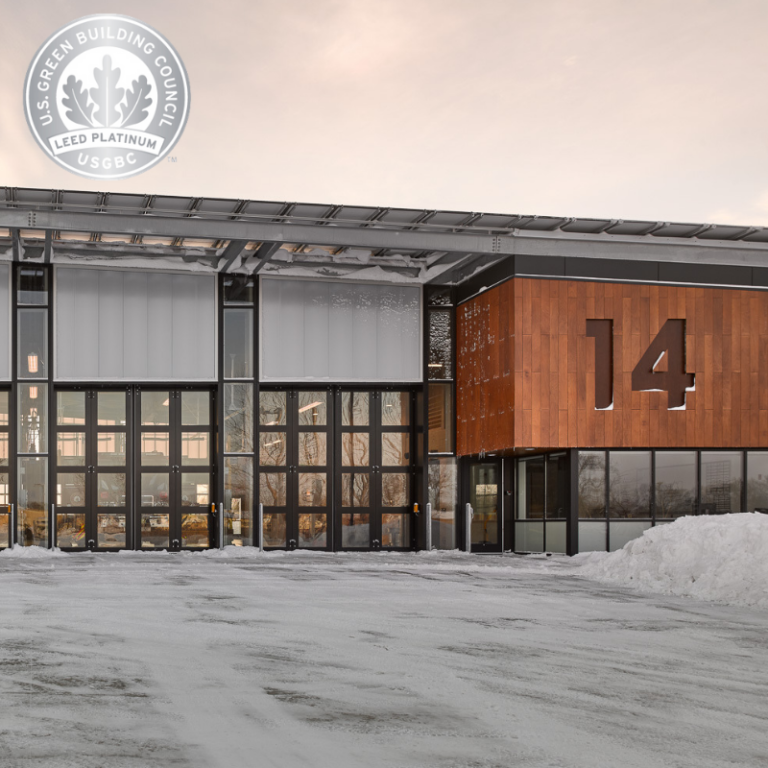Madison Fire Station 14 Awarded Prestigious LEED Platinum Certification

We are so pleased to share that the Madison Fire Station 14 has been awarded Leadership in Energy and Environmental Design (LEED) Platinum certification by the U.S. Green Building Association. Platinum is the highest level of LEED certification.
The station earned 85 of a total 110 points through the LEED (v2009) System for New Construction. LEED helps ensure buildings, homes and communities are designed, constructed, maintained and operated for improved environmental benefits and human health.
This is Madison’s second LEED Platinum project under USGBC’s New Construction program.
“Everyone involved with this project is very proud of achieving a platinum level certification and it was truly a team effort,” said Jon Evans, a project manager with the city’s engineering department. “In the case of Fire Station 14, the Madison Fire Department made a commitment to certify the building very early in the planning process. The City wants to minimize our environmental footprint while providing our residents high levels of customer service.”
Located at the intersection of Dairy and Femrite drives, Fire Station 14 fills a gap in emergency services in Madison by cutting response times in its service area by about half. The building design embraces the light industrial district in the rapidly growing corner of Madison. This state-of-the-art facility includes community meeting rooms and training rooms as well as space to house a double company and medical unit.
The station, which opened in December 2018, was designed to improve the health and wellbeing of the who live and work there 24-hours-a-day as well as achieve energy neutrality. Overall, the building is predicted to perform 72% better than a code-compliant building, saving the city both energy and expense.
The station was designed by OPN Architects, led by Principal Wesley Reynolds, Sustainability Director Tate Walker, and Project Architect Bryan Mann. It was built by Miron Construction Co.
“From both a cost and environmental impact perspective, sustainable design is incredibly important. For this project though, it was equally, if not more important, to consider the health and wellbeing of Madison’s first responders,” says Walker, who leads OPN’s sustainability efforts. “We were privileged to have partners like the city of Madison who embraced the goals of creating a highly functional, sustainable, and pragmatic building that is also a space where staff in high-stress jobs can relax, socialize, and connect with nature and the community they serve.”
The building tells the story of daylight. A stunning 50kW photovoltaic array runs the length of the building, providing shade and highlighting the simple shed form. Providing access to views and natural light are critical strategies for enhancing firefighters’ alertness and health. Regularly occupied areas of the building are located close to the perimeter to maximize views to the exterior. Occupancy sensors control both lighting and HVAC, and several spaces also have automatic daylighting controls to eliminate the need for artificial lighting at certain times of the day. A ground source heat pump with dedicated outside air system provide highly efficient thermal comfort with low first and operational costs.
Other environmental features incorporated into the building include low emitting materials, low-flow plumbing fixtures that reduce water consumption 40% below the baseline, materials with a high recycle content as well as materials that were extracted, harvested, and/or manufactured regionally, and the implementation of an on-site occupant recycling program that diverted 84% of waste from the landfill. The building also fits into its neighborhood and improves the watershed of which it is a part.
With more than two dozen LEED certified buildings, OPN also is proud to be among the 525 firms who have pledged to design 100 percent carbon-neutral projects by 2030. In 2018, the firm’s average energy savings across its entire portfolio of work is 60% above the 2030 baseline, outpacing the industry average of 44%.

